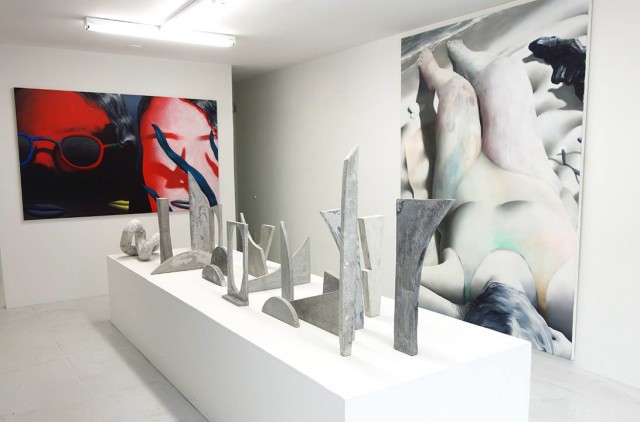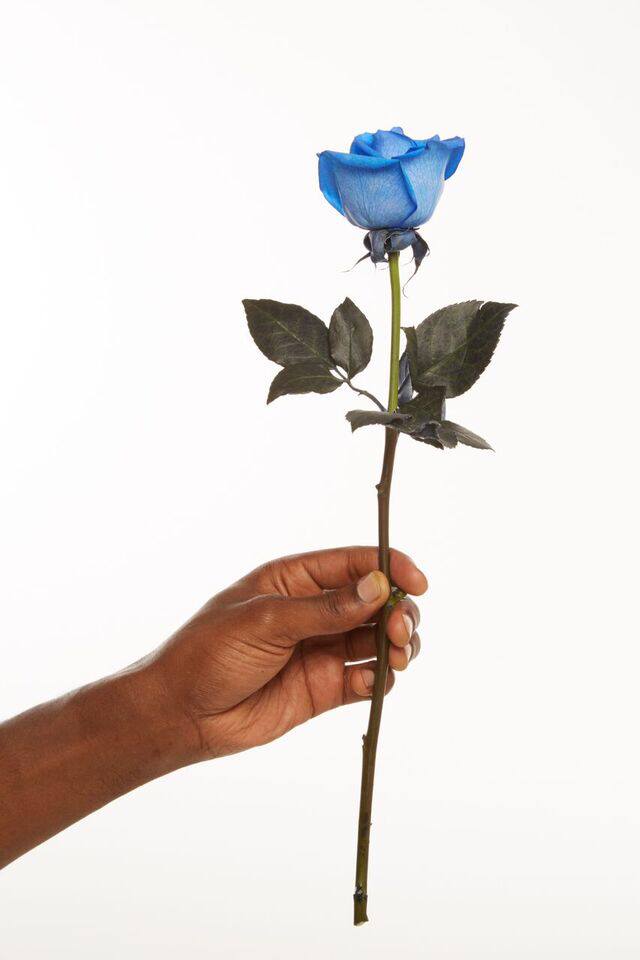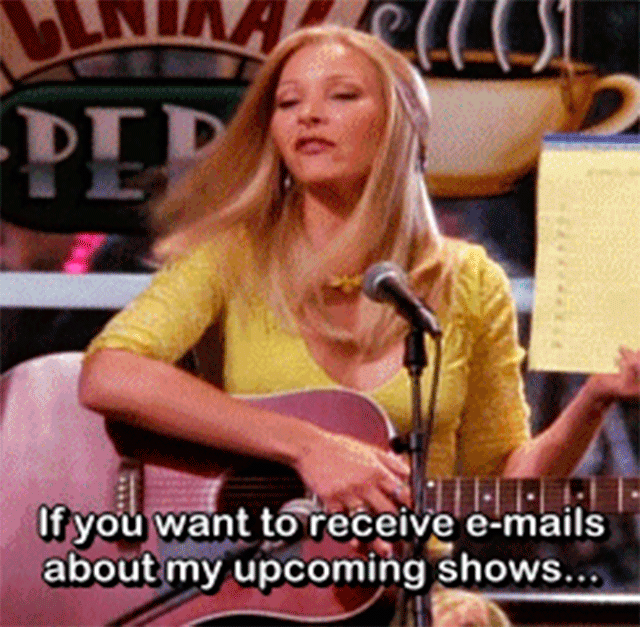
Phoebe’s inaugural exhibition, “Headspace,” featuring paintings by Jordan Kasey and sculptures by Carolyn Salas.
At the end of January, artist/critic/curator Alex Ebstein opened Phoebe, a new gallery in Baltimore that focuses on work by female-identified artists. It’s located at 510 W. Franklin Street, next door to Open Space and across the street from Alex’s loft, out of which she ran Nudashank (see AFC feature) with her partner Seth Adelsberger from 2009 to 2013. With one show under her belt, I decided it would be a good time to sit down with Alex. We chatted about the importance of spaces for women artists, the challenges and rewards of being a gallerist in Baltimore, and Virginia Poundstone’s upcoming solo exhibition, which opens at Phoebe this Saturday.
Michael Anthony Farley: Why don’t you start off by telling me a little about the gallery?
Alex Ebstein: Sure! As you know, the 510 space has previously housed two distinct gallery programs, SophiaJacob and Freddy. The block and neighborhood have become an arts district, home to a number of artist run spaces and coordinated events. After closing Nudashank in 2013 and focusing on my own studio practice (and Seth likewise on his), it was really exciting to see the art community grow and so many programs with unique approaches.

I couldn’t find a good photo of Phoebe’s exterior, but I did find the fantastically-accurate “510 W Franklin St” by Nicholas Buffon, a tiny sculpture of the building from 2014, when Buffon had a solo show at Freddy.
MAF: Considering you’re familiar with the challenges of running a gallery, especially in Baltimore, I’m surprised you wanted to do it again! What made you decide to get back in the game?
AE: When Freddy ended, it was at a point where the conversation in the larger art world, and issues in my own experience as an artist, had lead me to embrace my network of female artists and come together to discuss inequities experienced in various venues and institutions. I don’t necessarily see Baltimore as a place where women lack a strong presence in the art world at the moment—many of our museums and galleries are directed by strong female leaders—but the opportunities still seemed to tip toward one side of the gender scale. I wanted to address that.
MAF: So you’re entering new terrain. It’s funny, I always think of Baltimore as a very female-dominated city, especially in the arts. But it’s interesting to note that they’re almost entirely directors and curators of institutions, nonprofits, publications, and museums. A commercial art market is virtually nonexistent in Baltimore, but obviously the commercial art world at large is still so gender imbalanced.
AE: Right, and I think taking over a space like Freddy whose program was interested in a New York or non-Baltimore audience and continue to run it as a platform for connecting Baltimore with the larger art world was something I was interested in, sort of picking up the threads of both Freddy and Nudashank and trying to find a voice for what I thought was missing.
While this is not the stated mission of the gallery, I felt as an artist and curator, there was a lack of exhibitions in which women were presenting strong, formal work. I think much of the work I was seeing was about community and communication. I am not necessarily that kind of artist nor are many of the artists I admire. I wanted to show solitary studio pursuits, thoughtful researched concepts and be able to create a dialog about artists who work this way—even Nudashank was more about an interest in connections and drawing aesthetic parallels, and with Phoebe I had a chance instead to approach running a gallery a little bit differently.
MAF: Exactly! I seldom think about the gender of an artist when I’m looking at the type of work I tend to like unless it’s an obvious part of how it’s framed. It goes without saying the discourse over identity politics has intensified a lot in the past few years, and I think there’s some debate over whether or not this intense focus on the gender/race/sexual orientation of artists is “ghettoizing” certain practices. But also whether or not the new wave of all-female shows (I’m thinking specifically of No Man’s Land: Women Artists from The Rubell Family Collection) is liberating artwork by female artists from the burden of tokenism in otherwise male-dominated spaces.
AE: I am in the camp of liberating I suppose. For all the unchecked all-male shows, its funny to see people fret and debate about work that has nothing to do with gender being showcased in all-female shows.
MAF: Very true! But as a gallery that focuses on female artists do you think you would ever include a male artist in a group show at Phoebe if their work was a good fit?
AE: Of course! Also, I would pursue solo or two-person projects with male artists if it contributed to the dialog of the space. At the moment nothing is nailed down, but I have been doing some studio visits and some research.
MAF: You and Seth ran Nudashank out of your apartment. Now you have a storefront for Phoebe. How does it feel to have a dedicated, separate space? What’s different and what’s the same?
AE: It feels really separate from my studio practice and mindset which is really nice. For most of the time we ran Nudashank, it seemed like a sacrifice of studio time and identity as artist because I mostly worked out of the same space as the gallery and had to be much more judicious about studio time. I never wanted that to enter the same space we created to exhibit and best represent the work of other artists. The balance feels more possible with a designated space, no one identity eclipses the other.
MAF: I’m so impressed that you have the time and energy to run a gallery and write and have such a prolific studio practice. You have to be one of the most having-your-shit-together people in Baltimore!
AE: Maybe, except for when it comes to taxes and parking tickets. But thank you, it’s been a lesson in time management for sure, moreso than running an apartment space which I could absentmindedly work on all night.
MAF: Now that you’re running a storefront space that has the extra overhead of rent, do you feel more pressure for shows to be financially successful? Obviously everyone strives to make money, but do you find yourself thinking about Phoebe more business-oriented than you did running a space out of your home?
AE: I haven’t been, no… which is probably not wise. Phoebe is an opportunity for me to work and problem-solve with artists whose work and method I am inspired and/or puzzled by and see how they think through an exhibition. It’s honestly a little bit selfish, but also putting the business/commercial element second to the interest and ideas of the artists ensures shows that are exciting and complete. The overhead is pretty low, and I have been working hard to partner or trade with people who are interested in the project and can keep costs low… not financial sponsors or anything, just joining forces with other spaces for work pick up and return, etc.
MAF: That actually sounds like the wisest way to prioritize. I don’t think anyone opens a space in Baltimore with the idea of getting rich! But if you don’t mind talking business, I’m curious about your experience as a gallerist in Baltimore—have you found most sales came/come from your brick-and-mortar location, art fairs, or online? I was always so impressed by Nudashank’s web presence.
AE: Thank you! I think at first we prioritized affordability and appealing to our peers and saw a lot of local sales as a result. As our program grew and matured, we were eventually selling work almost exclusively to New York collectors or gallerists via email.
MAF: Have you been able to retain those connections and migrate some of that business to Phoebe?
AE: It’s hard to say with only a single exhibition under my belt, but I think so. I curated independently during and after Nudashank as well, so most of my immediate interest came from the contacts made through those more recent projects.
MAF: Speaking of your inaugural show, I’m so bummed I missed it! Could you talk about it?

Carolyn Salas, installation view.
AE: Sure! The inaugural show was a two person exhibition of paintings by Jordan Kasey, a friend and amazing painter who attended MICA and was an active Baltimore-based artist until she left us for New York, and Carolyn Salas, whose work I had admired since running Nudashank, but we ended the program before being able to show her work there.
MAF: I have always loved Jordan’s work. Ironically, I pictured “Jordan” as a boy for the longest time, before meeting her! (I believe that was back in the days before Facebook was as much a part of our lives as it is today.)
AE: I too am regularly mistaken for a man. Ha! Just today I was quoted in an article about Michael Dotson and it said “Alex Ebstein said it best in his interview with Dotson.”
MAF: It happens to the best of us. What else is on Phoebe’s horizon?
AE: The show that opens on Saturday is a solo show of photo, prints, and sculpture by Virginia Poundstone, an artist who’s based in New York but participates in the Baltimore art community via teaching at MICA.

Virginia Poundstone
A majority of the artists I am showing have either professional ties to Baltimore or provide a link between formal trends here and in larger cities.
Future exhibitions include work by Jessie Unterhalter and Katey Truhn, who are most known for their murals but also make incredible fiber works with appliqué and batik. They will show with Julia Bland and Evie Falci both of whom also elevate craft materials and techniques into the dialog of painting.
MAF: One last question—what made you pick the name Phoebe? A mythological reference?
AE: It’s a bit mythological, a bit ornithological, and a bit Friends/90s alt-feminism… Alt via mainstream, ha!
Phoebe is located at 510 W. Franklin St., Baltimore MD
Virginia Poundstone: The Blue Rose opens Saturday. April 2 from 7:00 p.m. – 10:00 p.m.



Comments on this entry are closed.